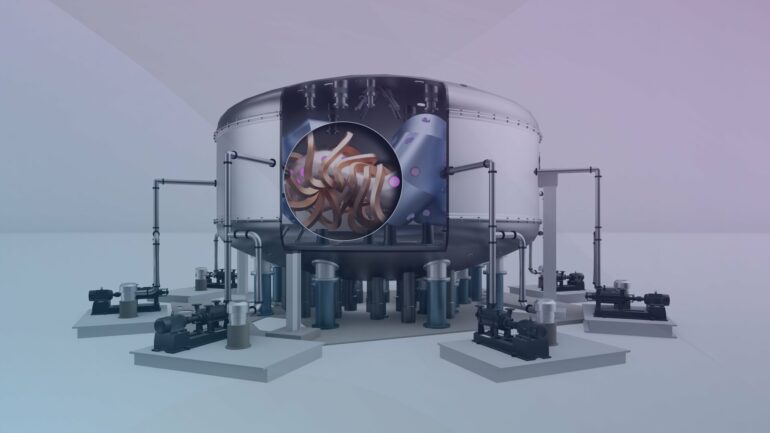Successfully harnessing the power of fusion energy could lead to cleaner and safer energy for all—and contribute substantially to combating the climate crisis. Towards this goal, Type One Energy has published a comprehensive, self-consistent, and robust physics basis for a practical fusion pilot power plant.
This groundbreaking research is presented in a series of six papers in the Journal of Plasma Physics (JPP).
The articles serve as the foundation for the company’s first fusion power plant project, which Type One Energy is developing with the Tennessee Valley Authority utility in the United States.
Alex Schekochihin, Professor of Theoretical Physics at the University of Oxford and Editor of the JPP, spoke with enthusiasm about this development:
“JPP is very proud to provide a platform for rigorous peer review and publication of the papers presenting the physics basis of the Infinity Two stellarator—an innovative and ground-breaking addition to the expanding family of proposed fusion power plant designs.
“Fusion science and technology are experiencing a period of very rapid development, driven by both public and private enthusiasm for fusion power.
“In this environment of creative and entrepreneurial ferment, it is crucial that new ideas and designs are both publicly shared and thoroughly scrutinized by the scientific community—Type One Energy and JPP are setting the gold standard for how this is done (as we did with Commonwealth Fusion Systems five years ago for their SPARC physics basis).”
The new physics design basis for the pilot power plant is a robust effort to consider realistically the complex relationship between challenging, competing requirements that all need to function together for fusion energy to be possible.
This new physics solution also builds on the operating characteristics of high-performing stellarator fusion technology—a stellarator being a machine that uses complex, helical magnetic fields to confine the plasma, thereby enabling scientists to control it and create suitable conditions for fusion. This technology is already being used with success on the world’s largest research stellarator, the Wendelstein 7-X, located in Germany, but the challenge embraced by Type One Energy’s new design is how to scale it up to a pilot plant.
Building the future of energy
Functional fusion technology could offer limitless clean energy. As global energy demands increase and energy security is front of mind, too, this new physics design basis comes at an excellent time.
Christofer Mowry, CEO of Type One Energy, is cognizant of the landmark nature of his company’s achievement and proud of its strong, real-world foundations.
“The physics basis for our new fusion power plant is grounded in Type One Energy’s expert knowledge about reliable, economic, electrical generation for the power grid. We have an organization that understands this isn’t only about designing a science project.”
This research was developed collaboratively between Type One Energy and a broad coalition of scientists from national laboratories and universities around the world. Collaborating organizations included the US Department of Energy, for using their supercomputers, such as the exascale Frontier machine at Oak Ridge National Laboratory, to perform its physics simulations.
While commercial fusion energy has yet to move from theory into practice, this new research marks an important and promising milestone. Clean and abundant energy may yet become reality.
More information:
Physics basis of the Infinity Two fusion power plant, Journal of Plasma Physics (2025). www.cambridge.org/core/journal … o-fusion-power-plant
C. C. Hegna et al, The Infinity Two Fusion Pilot Plant baseline plasma physics design, Journal of Plasma Physics (2025). DOI: 10.1017/S0022377825000364
L. Carbajal et al, Alpha-particle confinement in Infinity Two Fusion Pilot Plant baseline plasma design, Journal of Plasma Physics (2025). DOI: 10.1017/S0022377825000352
J.C. Schmitt et al, Magnetohydrodynamic equilibrium and stability properties of the Infinity Two fusion pilot plant, Journal of Plasma Physics (2025). DOI: 10.1017/S0022377825000406
D. W. S. Clark et al, Breeder blanket and tritium fuel cycle feasibility of the Infinity Two Fusion Pilot Plant, Journal of Plasma Physics (2025). DOI: 10.1017/S002237782500039X
A. Bader et al, Power and Particle Exhaust for the Infinity Two Fusion Pilot Plant, Journal of Plasma Physics (2025). DOI: 10.1017/S0022377825000273
W. Guttenfelder et al, Predictions of core plasma performance for the Infinity Two Fusion Pilot Plant, Journal of Plasma Physics (2025). DOI: 10.1017/S0022377825000339
Provided by
Cambridge University Press
Citation:
Commercial fusion power plant now closer to reality (2025, March 28)


